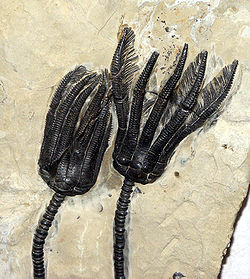
Back Stekelhuidiges Afrikaans شوكيات الجلد Arabic شوكيات الجلد ARZ কণ্টকচৰ্মী প্ৰাণী Assamese Echinodermata AST Dərisitikanlılar Azerbaijani دریسیتیکانلیلار AZB Энәтирелеләр Bashkir Ігласкурыя Byelorussian Іголкаваскурыя BE-X-OLD
| Echinoderms Temporal range: Late Ediacaran-Recent
| |
|---|---|

| |
| Sea urchin | |
| Scientific classification | |
| Domain: | |
| Kingdom: | |
| Subkingdom: | |
| Superphylum: | |
| Phylum: | Echinodermata
|

Echinoderms [1] are a successful phylum of marine animals. They include sea stars, brittle stars, sea urchins, sea cucumbers and their relatives.
Echinoderms have these features:[2]
- A skeleton of plates. These are formed from calcite, a mineral made of calcium carbonate. The plates are usually spiny, and the skeleton is covered outside and in by a layer of skin.
- Five-rayed (pentameral) symmetry.
- A water-vascular system. This is an internal system of tubes and bladders filled with water.
- Tube feet. These are extensions of the water-vascular system. The tube feet poke out from the skeleton, and are used in walking, respiration and feeding. The animal handles the world outside by using its tube feet.
- Stenohaline. They can't handle big changes in the salinity of the water. No doubt this is why they are:
- Entirely marine.
Echinoderms live in all parts of the ocean, but mostly on the sea floor. Some are filter feeders, and others (starfish) are important predators of molluscs and other shell-fish. They are extremely common near the shore, and on reefs.
They have a long and abundant fossil record. This phylum appeared in the early Cambrian period; it contains about 7,000 living and 13,000 extinct species. The four or five main groups are called sub-phyla by some authorities, and classes by others.
Echinodermata is the largest animal phylum which is entirely marine: no animals in this group live on land or in fresh or brackish water.
- ↑ Echinodermata, from the Greek for spiny skin
- ↑ Clarkson E.N.K. (1993). Invertebrate palaeontology and evolution. ISBN 978-0-412-47990-8.